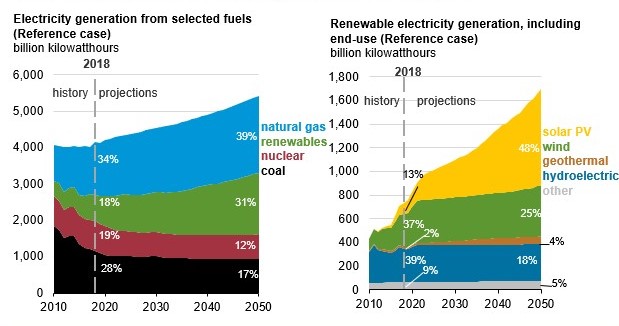- Distributed Energy Resources
- Demand-Side Management
- The Energy Cloud
- Utilities
EIA’s Annual Energy Outlook 2019: Not Business as Usual

The US Department of Energy’s Energy Information Administration (EIA) released its 2019 Annual Energy Outlook (AEO) in January and presented the results at the Bipartisan Policy Center (BPC) event.
Key Findings
- The US will become a net-energy exporter in 2020 and will remain so throughout the projection period as a result of large increases in crude oil, natural gas, and natural gas plant liquids production coupled with slow growth of US energy consumption.
- The power sector will experience a notable shift in fuels used to generate electricity, driven in part by low natural gas prices. Between 2019 and 2050 there will likely be increased natural gas-fired electricity generation, larger shares of intermittent renewables, and additional retirements of less economically viable, already existing coal and nuclear plants.
Traditional vs. Renewable Generation, 2010-2050

(Source: Energy Information Administration, Annual Energy Outlook 2019)
- Increasing energy efficiency across end-use sectors will keep US energy consumption relatively flat, even as the economy continues to expand. Delivered US energy consumption will likely grow across all major end-use sectors. However, increases in efficiency (represented by declines in energy intensity [the amount of energy consumed per unit of potential demand]) partially offset growth in total US energy consumption across all end-use sectors.
Energy Consumption by Sector (Reference Case), 2010-2050

(Source: Energy Information Administration, Annual Energy Outlook 2019)
- The steepest decline in energy intensity is in the transportation sector, with the level of energy used per highway vehicle-mile traveled declining by 32% from 2018 to 2050 as a result of increasingly stringent fuel economy and energy efficiency standards for light and heavy duty vehicles.
- Across end-use sectors, CO2 intensity likely declines with changes in the fuel mix despite overall increases in energy consumption. Historically, the transportation sector has the highest CO2 intensity. This trend continues in the projection because carbon-intensive petroleum remains the dominant fuel used in vehicles throughout the projection period. The aforementioned change in electricity generation resources result in the overall CO2 intensity of the electric power sector declining by 25% from the mid-2000s to 2018 and continuing to decline through 2050.
Insights from the Bipartisan Policy Center Event
At the BPC event, Gavin Bade, editor of Utility Dive, asked if any of the recent federal deregulation easing environmental restrictions on coal plants is included in the model. Linda Capuano, EIA Administrator said it is not and its “models are economic, but policy can trump that.”
Another audience member asked if strategic electrification is taken into account, but a representative from EIA replied that there is no intentional building electrification included, just whatever is a result of utility energy efficiency incentives.
AEO’s conclusions aligns with Guidehouse Insights’ view of the the Energy Cloud—moving toward a world of cleaner, more distributed energy resources. One may argue about the exact rate of change, but the overall trends are hard to dispute.